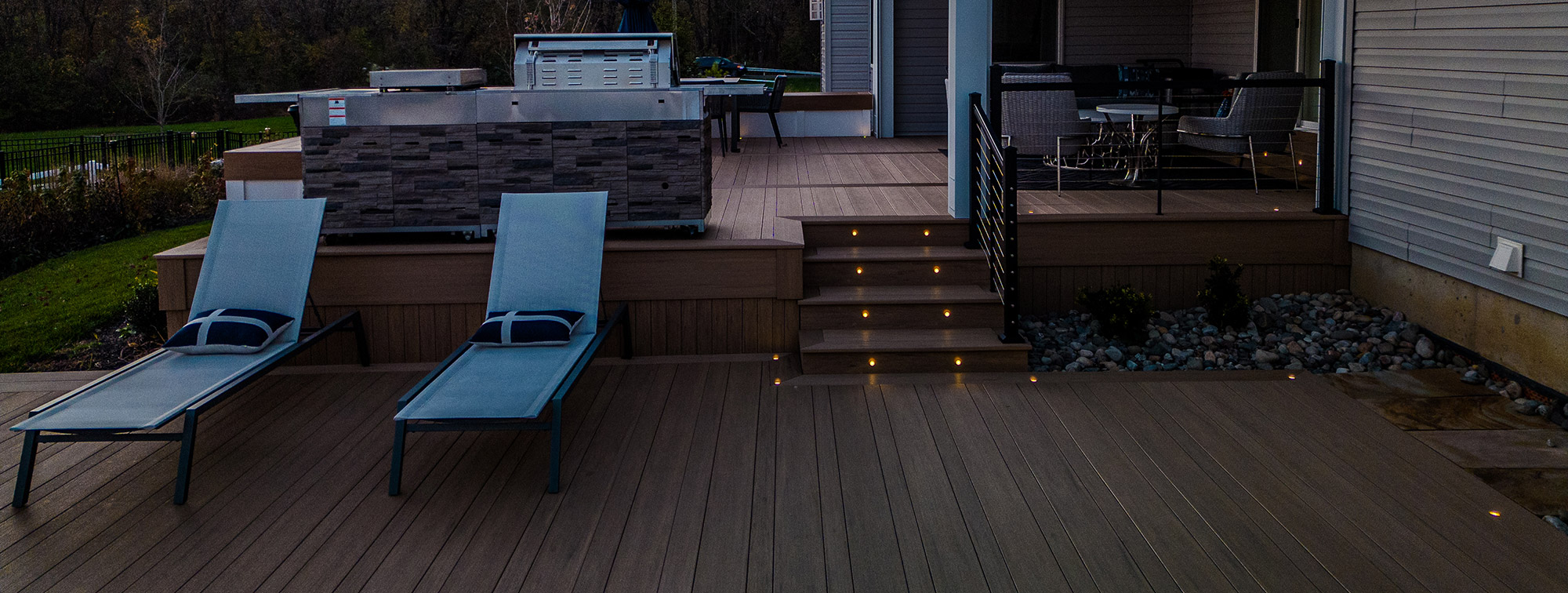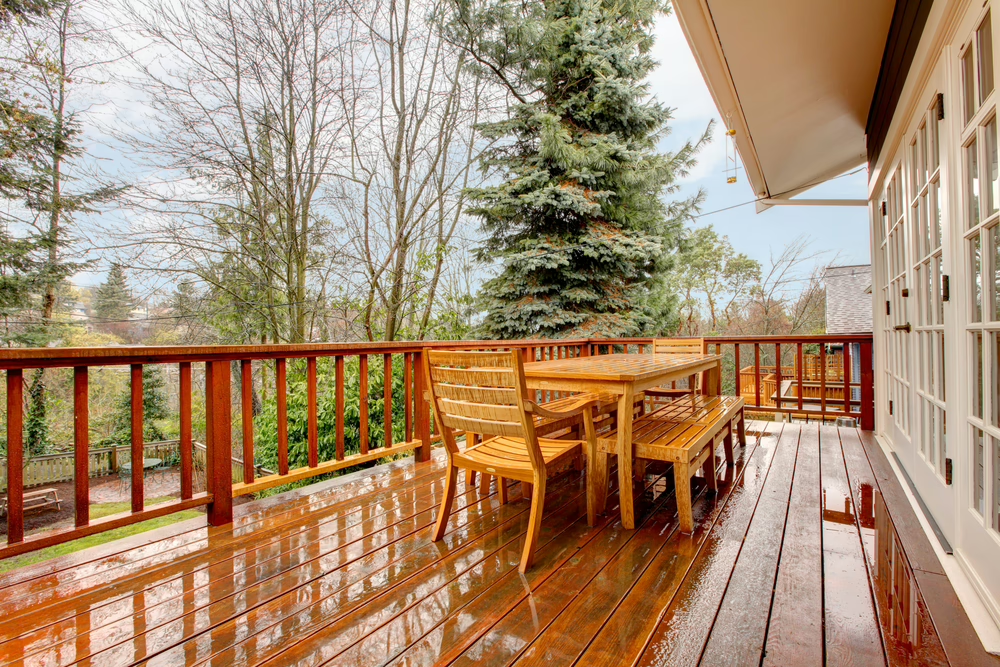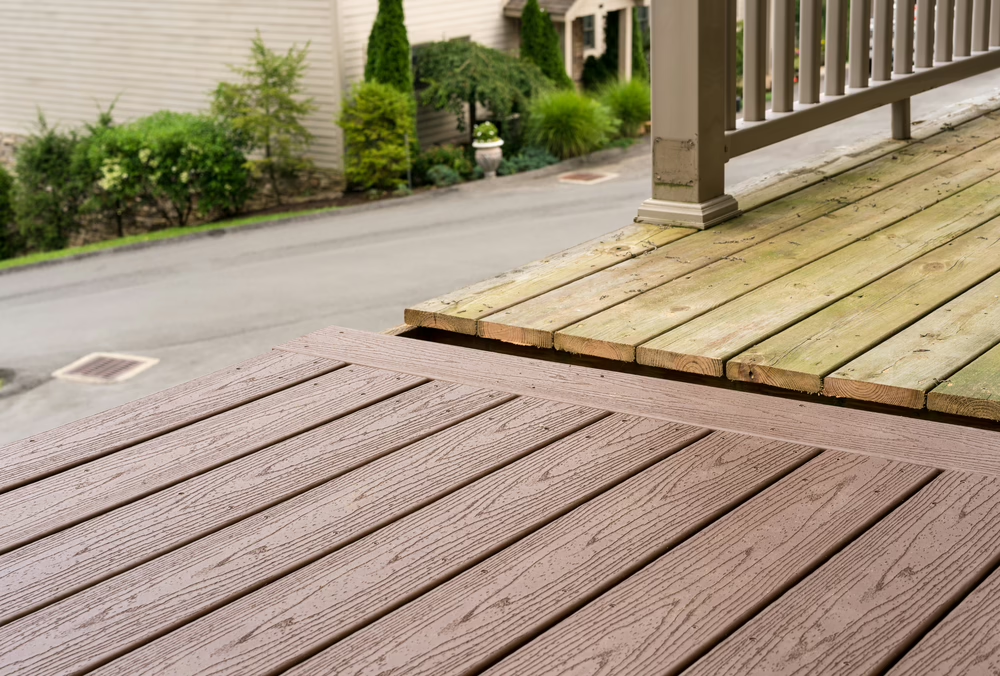You have a beautiful composite deck. It’s where you go for coffee in the morning or to relax in the evening. But dirt, grime, and other debris start to build up over time. You may be wondering how to pressure wash a composite deck without damaging the material and creating a headache for yourself. It’s a question many homeowners face, and it deserves careful thought. When you know how to properly pressure wash a composite deck, you can restore its beauty and maintain its appearance, making your outdoor living area more welcoming.
Why Pressure Wash Your Composite Deck?
Why should a composite deck be pressure washed? Despite its reputation for being low-maintenance, composite decking still requires routine cleaning. Especially in damp or shaded areas, dirt, pollen, mildew, and algae can build up on the surface. Moisture can produce dangerously slick conditions, and tannins from leaves can leave stains. This type of accumulation affects more than just appearance. It can make the deck more difficult to clean later and dangerous to walk on. Maintaining the appearance and functionality of your deck requires routine cleaning. A good method for thoroughly cleaning a surface and getting rid of dirt that a simple rinse cannot remove is pressure washing.
Maintaining the value of your investment and keeping your deck looking new are two benefits of cleaning. Even though composite materials are resistant to insects and rot, problems can still arise from neglect. Pressure washing gives your deck a fresh start, increases safety, and lessens the need for future maintenance. If you’re looking to upgrade or maintain your composite decking in Bucks County, PA, The Deck Expert offers expert solutions for long-lasting outdoor spaces.
Before You Start: Essential Prep Work
A big part of the work involves getting ready. Without taping the edges, you wouldn’t paint a room, would you? When cleaning composite decking, the same concept applies. Your composite deck boards will be safer and the actual washing process will go more smoothly if you do a little preparation. Additionally, it protects your deck and its surroundings, including any outdoor furnishings.
Check Your Deck Manufacturer’s Guidelines
When learning how to pressure wash a composite deck, this is an extremely important first step. There are differences among composite decking. They might suggest particular cleaner kinds or pressure settings. You run the risk of damaging your deck board or the deck surface as a whole if you disregard these instructions from the deck manufacturer. So, spend some time researching what your deck manufacturer says and follow their instructions. If you want to clean your deck effectively, this information is invaluable.
Gather Your Supplies
Composite decking can be cleaned more quickly and easily if the proper materials are prepared. You’ll be more organized at every turn and steer clear of distractions. What you’ll need is as follows:
- A composite-safe pressure washer.
- To prevent surface damage, use fan tip nozzles.
- For light tasks, use a mild soap and warm water solution or composite deck cleaner; make sure it works with more aggressive cleaners, such as those that contain oxalic acid.
- Wear goggles, gloves, non-slip shoes, long sleeves, and pants.
- Garden hose for rinsing the deck.
- Buckets for mixing cleaner.
- For difficult areas, use a soft-bristle brush rather than a wire or stiff brush.
- Tarps or plastic sheeting to protect siding or plants in the area.
Having these tools ready makes the work go more smoothly and helps keep your deck and surroundings safe.
Clear and Sweep the Deck
To prepare your composite deck for cleaning, remove all furniture, planters, grills, and toys. Then, sweep the area well to remove any loose dirt, leaves, or debris; if you skip this step, debris may fly into the air or embed itself in the deck while pressure washing. A clean surface makes pressure washing safer and more efficient.
Inspect for Damage
Look around a bit before you spray your deck with water. Examine the deck surfaces for any loose boards or screws that are sticking out. Are there any protruding screws? Are any deck boards cracked or otherwise damaged? Now is the time to address these minor problems. If you’re not careful, pressure washing can aggravate certain issues. A loose board, for instance, may become even more dislodged. Give this inspection a few minutes. This step in the check deck helps prevent more serious issues. You can avoid these problems by taking care of them before you begin cleaning.
Protect Surroundings
There is more to your composite deck than meets the eye. It is typically surrounded by landscaping and adjacent to your home. You might be surprised to learn how far a pressure washer’s spray can travel. Additionally, some deck cleaners are harmful for plants or some types of siding, even if they are safe for composite decking. Cover any plants that are at risk with those tarps or plastic sheets. Keep fragile shrubs or flowers away from the deck. Cover any electrical outlets outside as well. Think about covering the lower part of your siding as well if it is sensitive. By taking this precaution, you can avoid future damage and additional work.
Choosing the Right Pressure Washer and Settings for Composite Decks
Particularly for jobs involving composite decks, not all pressure washers are created equal. Although composite decking is tough, it is not invincible. One of the easiest ways to cause damage is to use the incorrect machine or settings. So, let’s discuss how to make wise decisions to avoid damaging your deck.
Pressure Washer Types
Electric and gas-powered pressure washers are the two most common options that are available. An electric pressure washer tends to be the better option for the majority of homeowners cleaning composite decks. They usually produce less pressure, which is perfect for composite materials. This decreases the possibility of accidentally cutting or leaving scars on your deck’s surface. In addition, they are typically easier to handle, lighter, and quieter. Pressure washers that run on gas are more powerful. They can clean more quickly, but the additional power they have carries a higher risk, especially if they use more pressure than is advised. Choosing the right nozzle and pressure setting are crucial if you’re using a gas model. They could void a stain warranty in the event of damage and are frequently overkill for a composite deck.
Understanding PSI (Pounds per Square Inch)
The water pressure that your machine releases is measured by PSI. For composite decks, this number is important. Some composite boards may lose their outer layer of protection if the PSI is too high. It can cut the surface, create fuzzing, or leave marks. What is a safe PSI, then? The majority of composite deck manufacturers advise maintaining a relatively low PSI pressure. For cleaning composite decking, 1300 to 1500 PSI is a typical range.
Some may argue that for some durable composite materials, you can go higher, up to 2500 PSI, but doing so is dangerous and should only be done with the deck manufacturer’s prior authorization. Experts in home improvement have provided specific PSI recommendations. Always, always start by reading the specific instructions provided by the deck manufacturer. The safest course of action is to start low. Damage from excessive pressure cannot be reversed, but you can always raise it a little if necessary.
Selecting the Correct Nozzle
Just as important as the PSI is the nozzle you select for your pressure washer. The water spray’s intensity and form are controlled by nozzles. If you use the wrong one, you risk damaging your deck by concentrating the pressure excessively. In general, a fan-tip nozzle works best for composite decks. Choose a nozzle that is 25 degrees (usually green) or 40 degrees (usually white). These disperse the water over a larger surface. This cleans well without being overly strong. The 40-degree nozzle is a good place to start when cleaning composite deck surfaces because it is softer and wider. The 0-degree nozzle (usually red) should be avoided at all costs.
This one emits a strong, extremely concentrated stream of water. It’s not for deck cleaning; it’s for blasting hardened debris off heavy machinery. It will most likely cause permanent lines or marks on the composite material. Additionally, rotating or turbo nozzles may be too forceful for a composite decking surface. To avoid damage and guarantee a simple cleaning procedure, it is best to avoid them for this task if you lack experience.
| Aspect | Recommendation | Notes |
| Pressure (PSI) | 1300-1500 PSI (up to 2500 PSI if manufacturer allows) | Always start low and check manufacturer guidelines. Avoid higher pressure unless specified. |
| Nozzle Type | Fan-tip: 25-degree (green) or 40-degree (white) | Start with 40-degree for gentlest action. NEVER use 0-degree (red) or turbo nozzles. |
| Distance from Surface | 8-12 inches (minimum) | Adjust based on test area results. Never get too close. |
The Step-by-Step Guide on How to Pressure Wash a Composite Deck
For many cleaning tasks, testing the area is the first rule, and it’s crucial in this case. Find a location to test your setup before tackling your entire composite decking. This could be in a hidden corner or beneath the typical location of a planter. Use the selected nozzle to set up your pressure washer; if you have a fan tip, start with a 40-degree tip. Start with a pressure setting that is lower than what you believe is necessary. Keeping the nozzle 12 inches or less from the surface, spray a small area. Keep a close eye out for any damage indicators on the deck board, such as etching, color changes, or surface fuzzing. If it looks good, you can try cleaning the deck more thoroughly by getting a little closer or, if necessary, using a 25-degree nozzle. This test helps you with choosing the ideal cleaning solution that is both safe and damage-free.
Apply a Composite-Safe Deck Cleaner
Even though you can occasionally get by with just water, a quality cleaner significantly improves the quality of your composite deck. Especially if you have algae, mildew, or tough-to-remove grime from things like food or drink stains. These can be removed from the surface with help of a cleaner. It allows the removal of pollen and makes pressure washing simpler and more efficient. Make sure the cleaner you select is marked as safe for composite decks.
Some well-known brands provide alternatives; for mild dirt stains, even a straightforward solution of dish soap and warm water works well. Always mix and apply products according to the directions on the label. Some can be used through the soap dispenser on the pressure washer or even with a pump sprayer. Allow the cleaner to remain on the surface for the suggested amount of time, which is typically five to fifteen minutes. Don’t let it dry on the deck, though. This can occasionally result in streaks or make rinsing more difficult, particularly if your water is hard.
Start Washing – The Technique
The next step in cleaning composite decking is washing. The lowest pressure that worked well in your test location should be used first. Hold the nozzle of the wand 8 to 12 inches away from the deck surface. Your machine and the test results will determine the precise distance. When cleaning composite decks, use smooth, sweeping motions with the spray wand. Avoid stopping or staying in one place for too long as this may leave marks. Wash in the grain’s direction if your composite deck exhibits a noticeable wood grain pattern, akin to that of natural wood or wood decking. In addition to looking the best, this can help keep the decking surface from streaking. Divide your work into manageable chunks. Your strokes should overlap by roughly one-third to one-half. By doing this, the lines between cleaned areas are less noticeable. Instead of allowing the spray to pool, try to aim it so that it pushes water and debris off the deck’s edge. To properly clean the surfaces of a composite deck, stay patient.
Dealing with Stubborn Stains
You might occasionally come across stains that are resistant to a standard wash. Special attention may be required for rust marks, berry stains, or grill grease (oil grease). You could need a spot cleaner designed specifically for that kind of stain on composite materials for these food or beverage stains. Follow the instructions on the spot cleaner. A little elbow grease may be required here, and you may need to gently scrub the area with a soft bristle brush. Steel wool and wire brushes will scratch and harm composite decking, so avoid using those items for your project.
Rinse Thoroughly
A thorough rinse is necessary after washing a section of the deck or the entire deck. All signs of cleaner residue and loose dirt should be removed. If the cleaner is left to dry it could leave a film or residue on your composite deck. Rinse with plain water using a garden hose or a low-pressure washer setting. Wash from the top of the deck and work your way down if your deck has several levels or steps. Make sure that the rinse water runs off the deck, as it could contain residue from dish soap or other cleaners. A thorough rinse makes your deck appear spotless and streak-free, which is important if you have hard water.
After Washing: Important Next Steps
After power washing, your deck looks much better. However, there is still work to be done. To properly wrap it up, a few more steps need to be completed. These last measures help your hard work pay off and make sure your composite deck continues to look great.
Allow to Dry Completely
After pressure washing, your composite deck will be wet. Before you start reorganizing items like outdoor furniture, it must completely dry out. Sometimes, if you walk on it while it’s really wet, you might leave footprints or scatter any last bits of dirt. The weather determines how long it takes to dry. It may only take a few hours on a bright, windy day. It might take longer, possibly overnight, if it’s humid or cool. Simply exercise patience. Your clean composite deck will be ready soon if you let nature do its thing.
Inspect Your Work
Examine the deck carefully after it has dried. Go over the entire deck and look for any areas you might have overlooked when cleaning it. Examine the decking surface for any stains or spots where dirt may still be present. When the deck is completely dry, this is much more visible. You can attempt spot cleaning again if you do discover a few trouble spots. Perhaps all you need is a little more cleaning solution and a light scrub with a soft bristle brush. Alternatively, a quick, cautious pass over that area might be sufficient. Catching these minor problems early is preferable. A beautiful deck is made possible in large part by this inspection.
Replace Furniture and Enjoy
It’s time to put back everything once you’re satisfied with the composite deck’s appearance and it’s completely dry. Place your planters, grill, furniture, and other items back where they belong. After that, take a moment to appreciate your spotless deck. You can now resume taking advantage of your outdoor living area. Your freshly cleaned Trex deck or TimberTech composite deck is ready for anything from lounging to entertaining near your outdoor kitchens to simply enjoying the sun. The task of cleaning composite decking has been successfully completed.
Common Mistakes to Avoid When Pressure Washing Composite Decks
Knowing what not to do is another aspect of learning how to pressure wash a composite deck. Composite materials are durable, but if you’re not careful, they can get damaged. Your deck will look fantastic for many years and require less maintenance if you avoid common mistakes. Using excessive pressure is a big mistake. Composite boards may be scarred or stripped by high PSI. Always test an area first and begin with low pressure. To work more quickly, resist the urge to turn it up. Another frequent problem is using the incorrect nozzle. Composite decking can sustain significant damage from a 0-degree pinpoint nozzle. For a softer spray, stick to fan tips like a 25- or 40-degree nozzle. Even so, damage can still result from holding the nozzle too close. Always test first and maintain a safe distance of 8 to 12 inches from the surface.
Another issue is allowing deck cleaner to dry on the boards. It may leave difficult-to-remove streaks or a hazy film behind. While the cleaner is working, keep the deck surface moist, and within the allotted time, give it a thorough rinse. Using the incorrect cleaner, like straight bleach, can cause discoloration or void your warranty, and incomplete rinsing can leave residue. Always pick a cleaner that has been specially marked as safe for composite materials. Also, stay away from abrasive tools. All you need for scrubbing is a soft bristle brush. You can safely clean your composite deck and preserve its appearance over time by avoiding these typical blunders. For homeowners planning a full deck transformation, custom deck installations in Yardley, PA can enhance your outdoor living space and pair perfectly with proper upkeep.
How Often Should You Pressure Wash Your Composite Deck?
Wondering how often a composite deck can be cleaned with pressure washing is a question that many homeowners have. For most composite decking, a thorough pressure wash once a year is sufficient, though there isn’t a one-size-fits-all solution. While some people prefer fall to clean up before winter, spring is a popular time to prepare for summer and remove pollen. The environment your deck is in determines the appropriate frequency. You might require more frequent or spot cleaning if it is shaded, under trees, or gets a lot of foot traffic. The sap, leaves, and droppings that decks near trees collect promote the growth of mold, mildew, and pests. Cleaning more than once a year could be beneficial in these situations.
You can cut down on the frequency of pressure washing sessions by performing routine light maintenance. Wipe up spilled food or beverages right away, and sweep often to get rid of dirt and debris. Maintaining the appearance of your deck is kept up by these practices. When it starts to look visibly dirty, it’s probably time for a clean.
Conclusion
Keeping your composite deck clean doesn’t have to be hard. Algae, dirt, and buildup are easily removed with careful technique, the correct pressure washer settings, and proper preparation. Always follow the advice of the deck’s manufacturer, such as Trex or TimberTech. In addition to being visually pleasing, a clean deck increases safety and improves your outdoor area. You are now prepared to give your composite deck a pressure wash to maintain its best appearance for many years to come. Ready to enjoy a cleaner, safer deck? Contact Deck Expert today to explore custom design options for your outdoor space.





